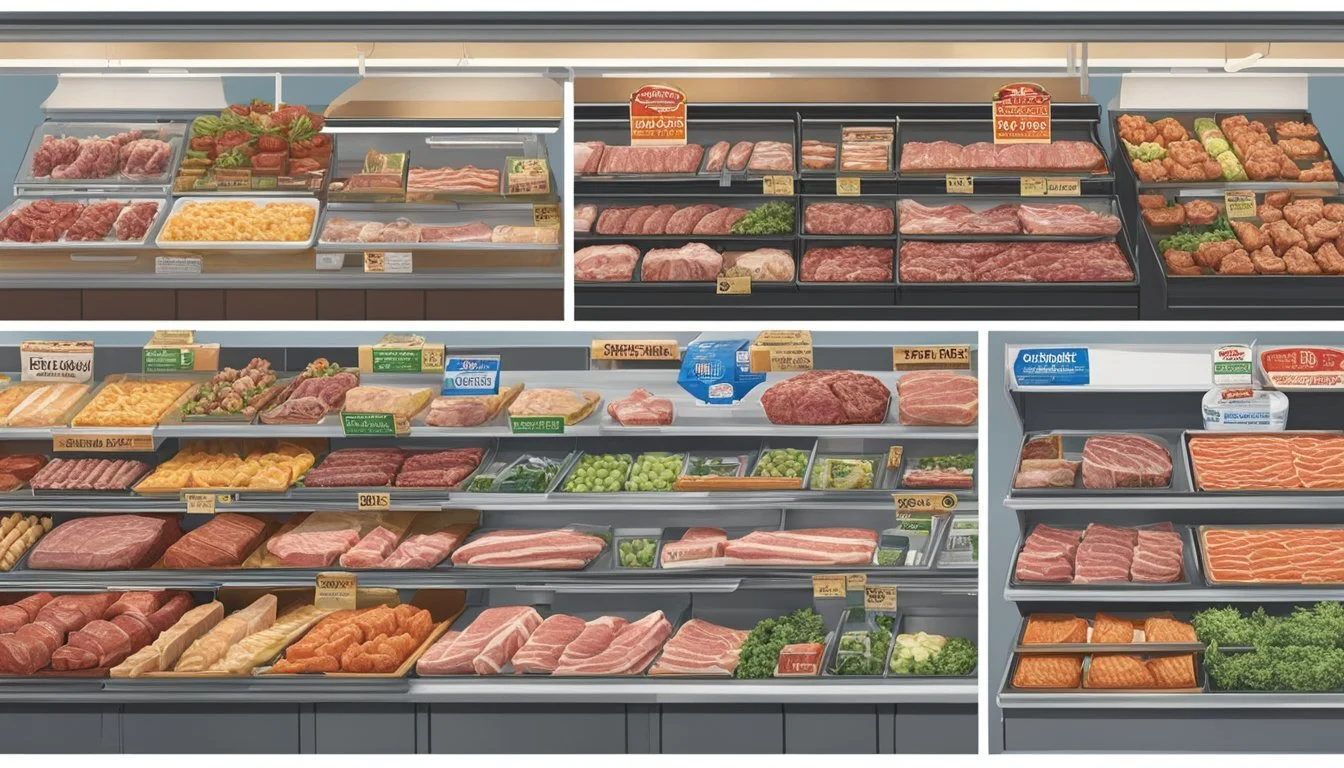Stater Bros. Markets vs Trader Joe's
Comparing Quality, Prices, and Selection
Grocery shopping can be a significant expense for many households, making the choice of store an important decision. Stater Bros. Markets and Trader Joe's are two popular options that offer distinct shopping experiences and product selections.
Stater Bros. Markets is known for its quality meat department and competitive prices. The chain has received praise for its customer service and the freshness of its meat and poultry offerings. Consumer Reports ranked Stater Bros. ninth in a 2017 survey of best places to grocery shop, highlighting its friendly staff and value for money.
Trader Joe's, on the other hand, has built a reputation for unique, often private-label products and affordable prices. A comparison of basic staples found Trader Joe's to be less expensive than some competitors, with a basket of nearly 50 items totaling $150.32 compared to higher prices at other stores. This price difference could lead to substantial savings for regular shoppers.
Company Overviews
Stater Bros. Markets and Trader Joe's represent two distinct approaches to the grocery business. Both have unique histories and business models that have shaped their current market positions.
History of Stater Bros. Markets
Stater Bros. Markets began in 1936 when twin brothers Cleo and Leo Stater opened a small grocery store in Yucaipa, California. The brothers purchased the market from Cleo's employer with a $600 down payment.
From this humble start, Stater Bros. grew into a significant supermarket chain in Southern California. The company now operates 171 stores across the region.
Stater Bros. has maintained a focus on traditional grocery offerings and customer service. This approach has earned them recognition, including a top 10 ranking in Consumer Reports' survey of best places to shop for groceries.
History of Trader Joe's
Trader Joe's began in 1958 as a small chain of convenience stores called Pronto Markets in the Los Angeles area. Founder Joe Coulombe transformed the concept in 1967, opening the first Trader Joe's store in Pasadena, California.
The company differentiated itself by offering unique, often imported products at competitive prices. This strategy proved successful, leading to expansion beyond California in the 1990s.
Trader Joe's is known for its private-label products, which make up about 80% of its stock. The chain has grown to over 500 stores nationwide, maintaining a cult-like following among customers who appreciate its curated selection and friendly atmosphere.
Store Locations and Convenience
Stater Bros. Markets and Trader Joe's have distinct geographical footprints. Their store locations and accessibility vary significantly, impacting customer convenience and shopping options.
Stater Bros. Store Locations
Stater Bros. Markets maintains a strong presence in Southern California. The chain operates over 170 stores across the region, with a particular focus on San Bernardino, Riverside, Los Angeles, and Orange counties. Stater Bros. stores are typically found in suburban and urban areas, providing convenient access for local residents.
Store sizes range from 45,000 to 80,000 square feet, offering ample space for a wide selection of products. Many locations feature additional amenities like pharmacies and bakeries. Stater Bros. emphasizes serving local communities, often positioning stores in neighborhood shopping centers.
Trader Joe's National Presence
Trader Joe's boasts a broader geographical reach with over 500 stores across the United States. The chain has expanded from its California roots to establish a strong presence on both the East and West Coasts. Trader Joe's stores can be found in major metropolitan areas and suburban locations alike.
Typical Trader Joe's stores are smaller than traditional supermarkets, averaging around 10,000 to 15,000 square feet. This compact format allows for strategic placement in urban centers and high-traffic areas. The chain's expansion strategy focuses on densely populated regions, often competing with specialty grocers and conventional supermarkets.
Trader Joe's unique product offerings and curated selection attract customers from wider areas, sometimes leading to crowded parking lots and longer checkout lines during peak hours.
Price Comparison and Cost Effectiveness
Stater Bros. Markets and Trader Joe's employ distinct pricing strategies to attract customers. Both aim to provide value, but their approaches differ in key ways.
Pricing Strategies of Stater Bros.
Stater Bros. focuses on competitive pricing for everyday essentials. The chain regularly offers deals and discounts, particularly on staple items like milk, bread, and produce. Stater Bros. uses a loyalty card program to provide additional savings to frequent shoppers. The store often runs weekly specials and promotions to draw in budget-conscious customers.
Stater Bros. tends to have lower prices on national brands compared to some larger chains like Safeway or Kroger. Their store-brand products offer further savings without sacrificing quality. For bulk purchases, Stater Bros. prices can be competitive with warehouse clubs like Costco.
Trader Joe's Price Philosophy
Trader Joe's takes a different approach to pricing. The store focuses on keeping costs low across the board rather than offering frequent sales or a loyalty program. Trader Joe's achieves this through a limited selection of mostly private-label products.
A price comparison study found Trader Joe's to be cheaper than Stop & Shop on 48 basic grocery items, with a total bill of $150.32 compared to Stop & Shop's higher amount. Trader Joe's often beats competitors on produce prices, with items like bananas consistently cheaper.
Trader Joe's aims to provide unique, high-quality products at affordable prices. While not always the cheapest option for every item, many shoppers find the overall value proposition attractive.
Product Range and Quality
Stater Bros. Markets and Trader Joe's offer distinct product ranges and quality standards. Both stores cater to different customer preferences, with varying strengths in fresh produce, meats, and specialty items.
Fresh Produce and Organic Options
Stater Bros. Markets provides a wide selection of fresh fruits and vegetables. They source produce from local farms when possible, ensuring freshness and supporting regional agriculture. Their organic section has expanded in recent years, offering more choices for health-conscious shoppers.
Trader Joe's, while having a smaller produce section, focuses on quality and uniqueness. They offer many organic options and frequently introduce seasonal fruits and vegetables. Trader Joe's is known for pre-packaged salads and ready-to-eat produce items, catering to convenience-seeking customers.
Both stores maintain competitive pricing on their produce, but Trader Joe's often edges out with lower prices on organic items.
Meat and Poultry Departments
Stater Bros. Markets boasts a full-service meat department with trained butchers on staff. They offer a wide range of USDA Choice beef cuts, fresh poultry, and pork options. Customers can find both conventional and organic meats, including grass-fed beef and free-range chicken.
Trader Joe's meat selection is more limited but focuses on quality. They offer pre-packaged cuts of beef, chicken, and pork, with an emphasis on organic and antibiotic-free options. While they don't have a full-service butcher counter, their meat quality is generally high.
Stater Bros. typically provides more variety in cuts and package sizes, while Trader Joe's excels in offering unique marinades and seasoned meats.
Private Label and Specialty Products
Trader Joe's is renowned for its extensive private label offerings, covering nearly 80% of its products. These items often feature innovative flavors and ingredients, from snacks to frozen meals. The store frequently introduces new products, keeping the shopping experience exciting for customers.
Stater Bros. Markets has its own private label brand, offering quality products at lower prices than national brands. While not as extensive as Trader Joe's, their selection covers most basic grocery needs. Stater Bros. also carries a wide range of national brands, providing more familiar options for shoppers.
Both stores offer specialty products, but Trader Joe's is known for its unique international flavors and trendy food items. Stater Bros. focuses more on traditional grocery staples and local favorites.
Consumer Experience and Service
Stater Bros. Markets and Trader Joe's offer distinct shopping experiences and levels of customer service. Both stores prioritize customer satisfaction but take different approaches to achieve it.
In-Store Shopping Experience
Stater Bros. Markets provides a traditional supermarket layout with wide aisles and clearly organized sections. The stores are typically spacious, allowing for easy navigation. Shoppers can find a comprehensive selection of groceries, including fresh produce, meats, and household items.
Trader Joe's, on the other hand, offers a more compact and unique shopping environment. The stores are smaller, with a carefully curated selection of products. Many items are Trader Joe's branded, creating a distinctive atmosphere. The layout encourages exploration, with new and seasonal items regularly featured.
Both stores maintain clean and well-stocked shelves. Stater Bros. focuses on a familiar, efficient shopping experience, while Trader Joe's aims for a more adventurous and intimate feel.
Customer Service and Satisfaction
Stater Bros. Markets has earned recognition for its quality customer service. In Consumer Reports' 2017 survey, the chain received high ratings for staff helpfulness and competitive prices. Employees are often praised for their attentiveness and willingness to assist customers.
Trader Joe's is renowned for its friendly and knowledgeable staff. Employees, called "Crew Members," are trained to engage with customers and offer product recommendations. The store's unique approach to service includes ringing bells for assistance and fostering a casual, welcoming atmosphere.
Both chains consistently receive positive reviews from satisfied consumers. Stater Bros. excels in traditional customer service, while Trader Joe's creates a more informal, interactive experience. Customer satisfaction ratings for both stores tend to be above average in industry comparisons.
Ethical Practices and Supplier Relationships
Stater Bros. Markets and Trader Joe's both emphasize responsible sourcing and environmental stewardship. Their approaches differ in key areas, impacting product quality and consumer trust.
Sourcing and Animal Welfare
Stater Bros. Markets supports the California Transparency in Supply Chains Act, opposing slavery and human trafficking in their supply chain. They expect suppliers to follow similar ethical standards. Stater Bros. offers a selection of organic and locally sourced products.
Trader Joe's has faced scrutiny over its supplier relationships. The company has made efforts to improve transparency, but some critics argue they could do more. Trader Joe's emphasizes affordability, which can sometimes conflict with higher-cost ethical sourcing practices.
Both stores offer antibiotic-free and hormone-free meat options. Trader Joe's has a wider range of organic choices. Stater Bros. focuses on partnering with local farms for fresh produce.
Environmental Impact and Sustainability
Stater Bros. Markets has implemented energy-efficient technologies in stores and distribution centers. They've also increased recycling efforts and reduced packaging waste.
Trader Joe's has faced criticism for excessive plastic packaging. In response, they've committed to reducing plastic use and increasing recyclable packaging. The company has also pledged to improve its seafood sustainability practices.
Both chains have room for improvement in their sustainability efforts. Trader Joe's quirky branding sometimes overshadows its environmental impact. Stater Bros. could expand its eco-friendly product offerings to match consumer demand.
Marketing and Brand Image
Stater Bros. Markets and Trader Joe's employ distinct marketing strategies to attract and retain customers. Both chains have cultivated unique brand identities that set them apart in the competitive grocery landscape.
Stater Bros. Marketing Approach
Stater Bros. Markets recently launched a rebranded image with the "Bring It Home" campaign. This initiative aims to connect with Southern California families by emphasizing fresh food and meal solutions. The company focuses on local appeal, positioning itself as a community-oriented grocery store.
Stater Bros. utilizes traditional advertising methods, including television commercials and print ads. Their marketing emphasizes value, quality, and customer service. The chain's branding often highlights its long-standing presence in the region, appealing to customers' sense of loyalty and familiarity.
Trader Joe's Unique Branding
Trader Joe's has cultivated a cult-like following through its distinctive marketing approach. The company eschews traditional advertising, relying instead on word-of-mouth and its quirky in-store experience to build brand awareness.
Trader Joe's positions itself as "gourmet on the cheap," offering unique, high-quality products at affordable prices. The store's red color scheme distinguishes it from competitors like Whole Foods. Trader Joe's leverages its private-label products, themed decor, and friendly staff to create a memorable shopping experience.
The chain's Fearless Flyer, a product catalog disguised as a playful newsletter, serves as a key marketing tool. This unconventional approach aligns with Trader Joe's offbeat brand image and helps maintain customer engagement.
Meat Department Analysis
Stater Bros. Markets and Trader Joe's offer distinct experiences in their meat departments. Both stores aim to provide quality products, but their approaches differ significantly in terms of selection and services.
Quality of Meat Selection
Stater Bros. Markets prides itself on a diverse meat selection. The store offers various cuts of beef, pork, poultry, and lamb. Their beef selection includes premium steaks with excellent marbling, contributing to a tender and flavorful eating experience.
Stater Bros. also carries 100% grass-fed beef options for health-conscious consumers. The meat department frequently rotates specialty items and seasonal offerings.
Trader Joe's, in contrast, provides a more curated meat selection. While smaller in range, their offerings focus on quality over quantity. Trader Joe's meat products often come pre-packaged, with an emphasis on convenience.
Butcher Services and Meat Counter
Stater Bros. Markets features a full-service meat counter with on-site butchers. These professionals offer custom cuts, trim fat, and provide cooking advice. Customers can request specific thicknesses or weights for their steaks and roasts.
The butchers at Stater Bros. also prepare special orders and can accommodate unique requests. This personalized service adds value for shoppers seeking specific cuts or preparations.
Trader Joe's takes a different approach, focusing on pre-packaged meats. While they don't offer a traditional butcher counter, their meat products are carefully selected for quality. The store emphasizes easy-to-prepare options, catering to time-pressed consumers.








